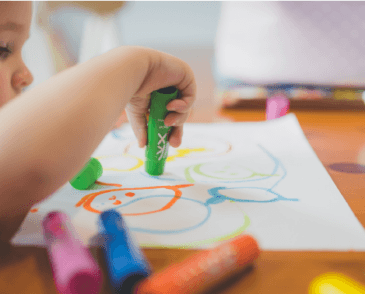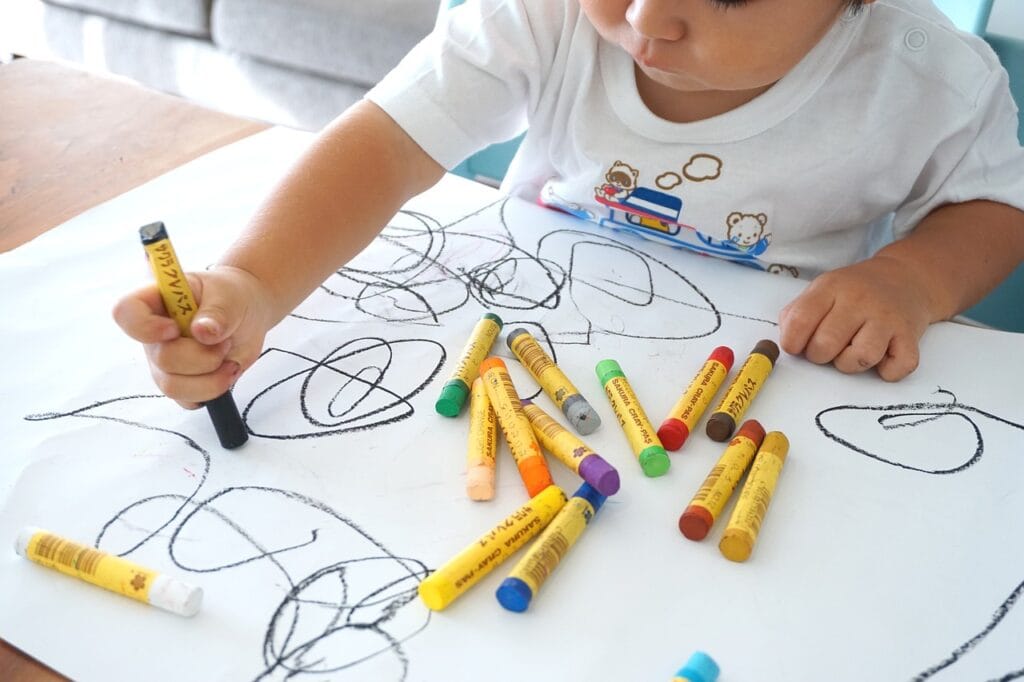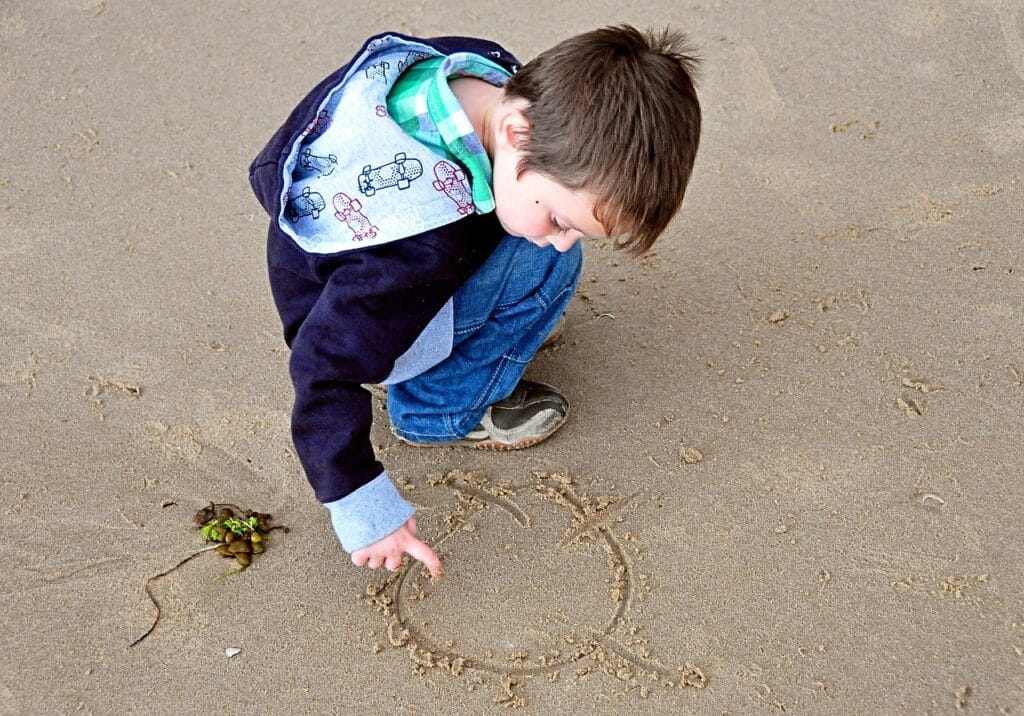

Last Updated - November 11, 2024
Mark Making
Find out why mark making is so important and discover our top tips for supporting this in the early years.
Making scribbles with pens, creating hand prints with paint and drawing patterns in the sand, aka mark making, are all signs you’ll see on the lead up to writing in the early years.
Did you know?
- You can use a paint brush and water to make marks outside.
- You can use a stick to create marks in the sand at the beach.
- You can press objects into playdough to make marks too.
Mark making is the beginning of a child’s journey to writing and is an important step in a child’s development. It also helps with fine and gross motor skills.
What is mark making?
If you work in early childhood education, you’ve likely heard the term “mark making” quite often. But what exactly does it mean, and how does it benefit children’s development?
Mark making encompasses all the scribbles and patterns that children naturally create. Whether it’s drawing patterns in the sand with their fingers, scribbling on paper with a crayon, dipping their fingers in spilled food, or drawing lines in the mud with a stick, these activities are the beginnings of mark making. Children do this almost instinctively, without needing any instruction.
When babies and toddlers start making marks intentionally using their bodies or various tools, they are taking their first steps towards writing and drawing. No matter how children mark make, this is a very important step in both physical development and cognitive development and should be encouraged whenever you spot it!
How does mark making encourage writing?
When children create marks through art or by drawing patterns, they are using essential physical development tools needed for writing. However, this doesn’t mean you can’t encourage mark making in other ways. In fact, engaging in mark making on a larger scale outdoors is particularly beneficial as it promotes ‘whole arm’ movements. These movements help build the foundation of muscle control necessary for holding a pencil correctly.
The benefits of mark making include:
When children create marks through art or by drawing patterns, they are using essential physical development tools needed for writing. However, this doesn’t mean you can’t encourage mark making in other ways. In fact, engaging in mark making on a larger scale outdoors is particularly beneficial as it promotes ‘whole arm’ movements. These movements help build the foundation of muscle control necessary for holding a pencil correctly.
Physical Development
As children experiment with making marks, they learn to use their bodies in various ways. This promotes fine and gross motor skills, different grips, and body control, all of which are essential for writing.
Expressive Arts & Design
Mark making and drawing lines or patterns that represent something else allow children to express themselves creatively. It provides a new way for them to convey their feelings more permanently, rather than through sounds and movement. This activity sparks their imagination and helps them share their thoughts through pictures and stories.
Mathematics
Mark making can lay the foundation for understanding numbers and shapes, leading to the development of mathematical skills.
While some children may already know how to write numbers or form simple words, it’s important to encourage them without rushing through this stage, as children progress at different rates.
Tips for Encouraging Mark Making at Home
Supporting mark making at home can be both fun and beneficial for your child’s development. Here are some practical tips for parents:
- Provide a Variety of Materials: Offer different tools like crayons, markers, chalk, paint, and even sticks for outdoor drawing. Having a range of materials can make mark making more exciting.
- Create a Dedicated Space: Set up a specific area for mark making, whether it’s a small table indoors or a spot in the garden. This helps children associate the space with creativity.
- Encourage Outdoor Activities: Use chalk on the pavement, draw in the sand, or make patterns in the mud. Outdoor mark making allows for larger movements and can be very engaging.
- Incorporate Everyday Activities: Encourage mark making during daily routines, like drawing shapes in spilled flour while baking or using a finger to draw in condensation on windows.
- Celebrate Their Work: Display your child’s creations around the house. This boosts their confidence and shows that you value their efforts.
- Join In: Participate in mark making activities with your child. This not only makes it more enjoyable but also provides an opportunity for bonding.
- Encourage Experimentation: Let your child experiment with different grips and movements. This helps develop their fine and gross motor skills.
- Use Technology Wisely: Digital drawing apps can also be a fun way for children to engage in mark making, but balance screen time with physical activities.
- Read and Draw Together: Combine storytelling with drawing. Ask your child to draw scenes from their favourite stories or create their own illustrations.
- Be Patient and Positive: Every child progresses at their own pace. Encourage their efforts and celebrate their progress without rushing them.
By incorporating these tips, you can create a supportive environment that nurtures your child’s mark making and overall development.
Indoor Activities
Mark making on 3D objects uses different muscles than making marks on a flat piece of paper, strengthening muscles in fingers, hands, arms and shoulders.
Marks can also be made in materials such as dry sand, flour, glitter etc using use a finger. If in individual trays, children can make their marks then when finished, give the tray a shake and you have a blank canvas ready for more marks to be made.
- Finger Painting: Use washable paints and let your child create patterns and pictures with their fingers.
- Chalkboard or Whiteboard: Provide chalk or dry-erase markers for drawing and writing. Chalk is chunky and easy for little hands to hold to draw and doesn’t require much pressure for a mark to be made.
- Scribble Station: Set up a table with paper, crayons, markers, and coloured pencils for free drawing.
- Playdough Patterns: Roll out playdough and use tools or fingers to make marks and shapes.
- Water Painting: Use a brush and water to paint on a chalkboard or a piece of dark construction paper.
- Sand Tray: Fill a tray with sand or rice and let your child draw patterns with their fingers or small tools.
- Stickers and Stamps: Use stickers and stamps to create pictures and patterns on paper.
- Drawing in Flour: Spread flour on a baking tray and let your child draw with their fingers.

Outdoor Activities
- Pavement Chalk: Draw on the pavement with colourful chalk.
- Mud Painting: Use sticks or fingers to draw in the mud.
- Nature Brushes: Create brushes from leaves, twigs, and flowers, and use them to paint with water or mud.
- Water Play: Use a paintbrush and water to draw on the pavement or fence.
- Sand Art: Draw patterns in a sandbox or at the beach.
- Leaf Rubbings: Place paper over leaves and rub with crayons to create leaf patterns.
- Garden Drawing: Use sticks to draw in the soil or sand in the garden.

Creative Activities
- Story Drawing: Read a story and ask your child to draw scenes from it.
- Shape Tracing: Provide stencils or objects to trace around.
- Collage Making: Use different materials like paper, fabric, and natural items to create a collage.
- Bubble Wrap Painting: Paint on bubble wrap and press paper onto it to create textured prints.
- Shadow Drawing: Place objects in the sunlight and trace their shadows on paper.
These activities not only support mark making but also encourage creativity, fine motor skills, and imaginative play. Enjoy creating and exploring with your child!
